Abstract
Loss of heterozygosity for sequences located on chromosome 17p in several tumor types is often associated with mutations in the tumor suppressor gene p53. We previously showed consistent deletion of chromosome 17p12-13.1 in medulloblastoma, a common childhood brain tumor. Using denaturing gradient gel electrophoresis and direct sequencing, we have detected p53 mutations in only two of 20 medulloblastoma specimens. Moreover, additional RFLP studies of these 20 specimens showed loss of heterozygosity at a more distal and distinct site, 17p13.3. Deletion of 17p almost invariably signified a negative prognosis. Our results suggest that p53 mutations may contribute to the pathogenesis of medulloblastoma in relatively few cases. The consistent deletion of other discrete loci on 17p suggests that additional or alternative tumor suppressor genes may contribute to the tumor's phenotype.
Full text
PDF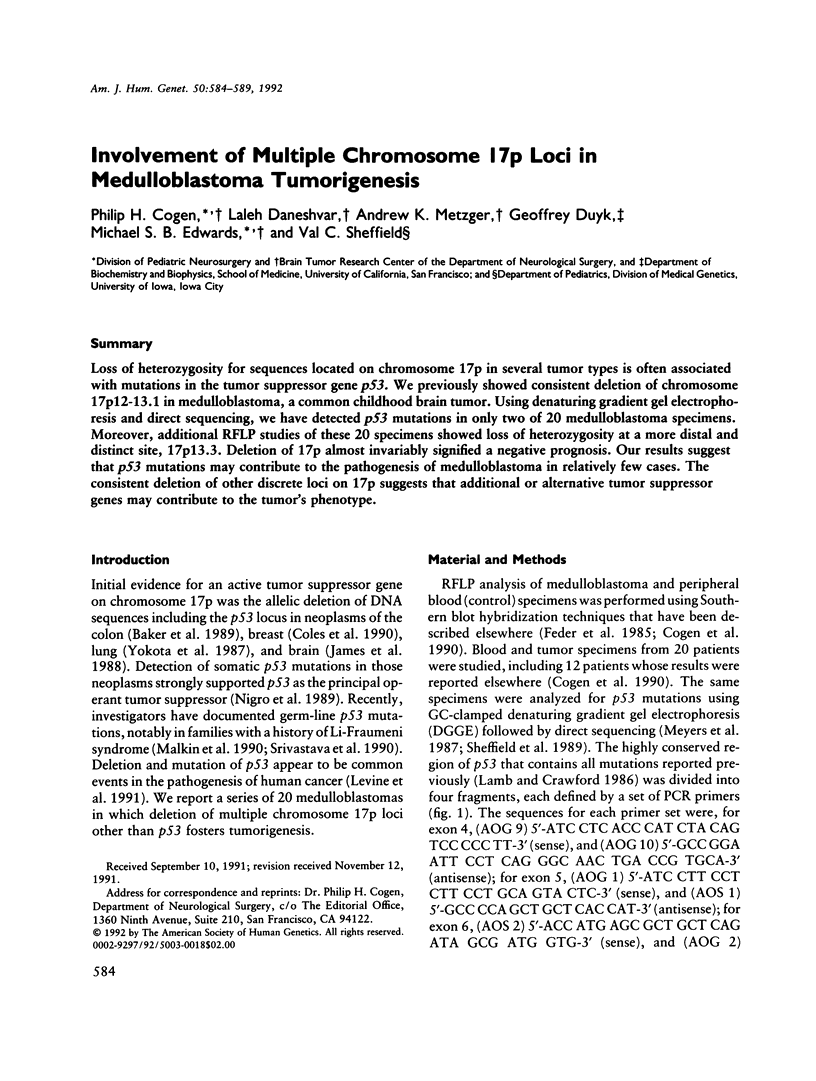
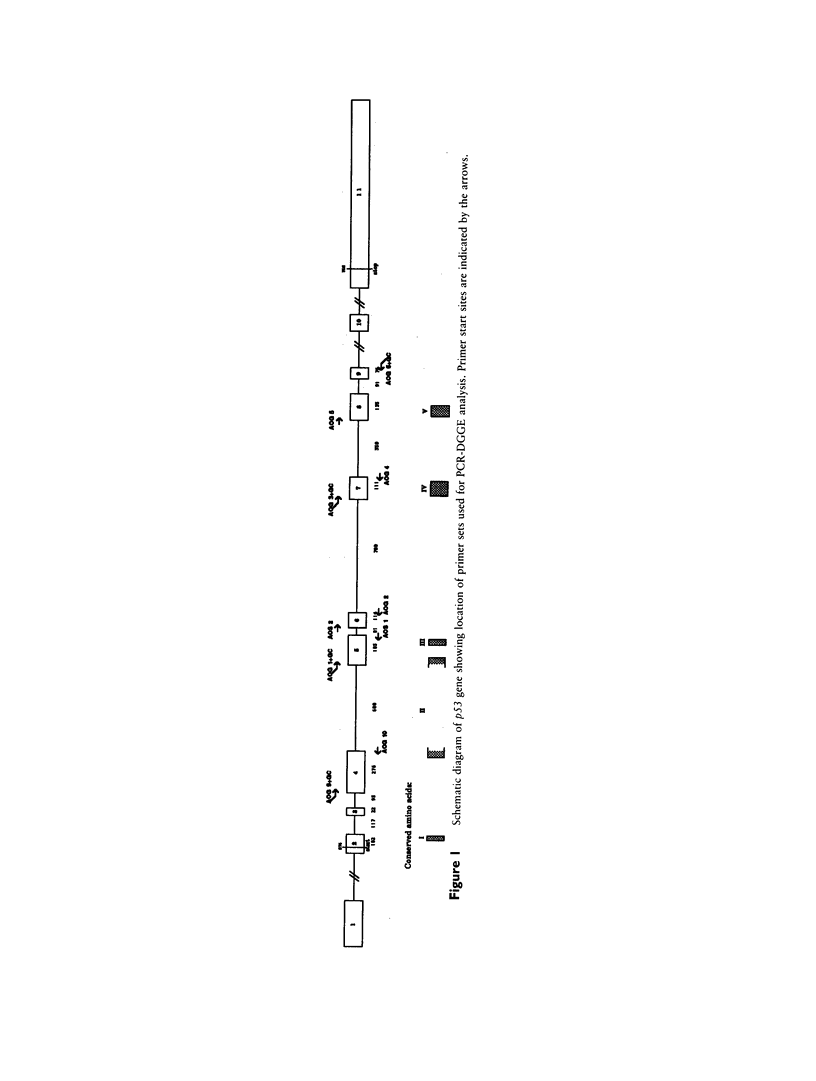
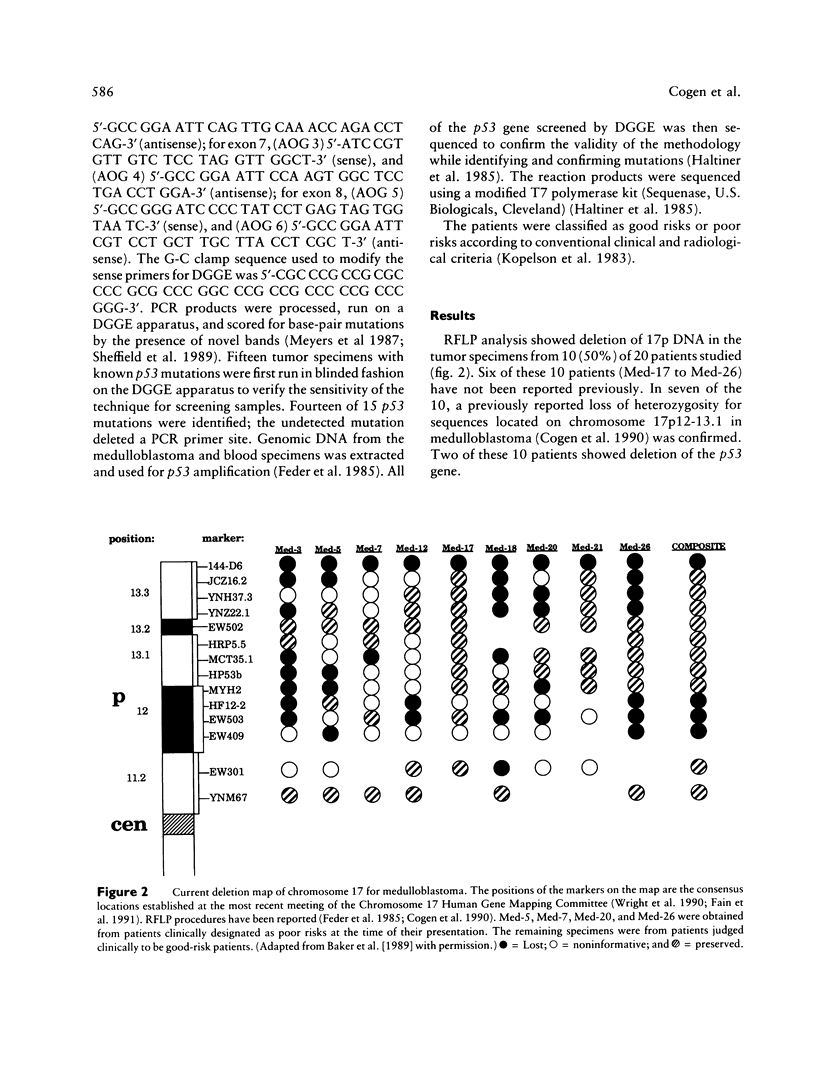
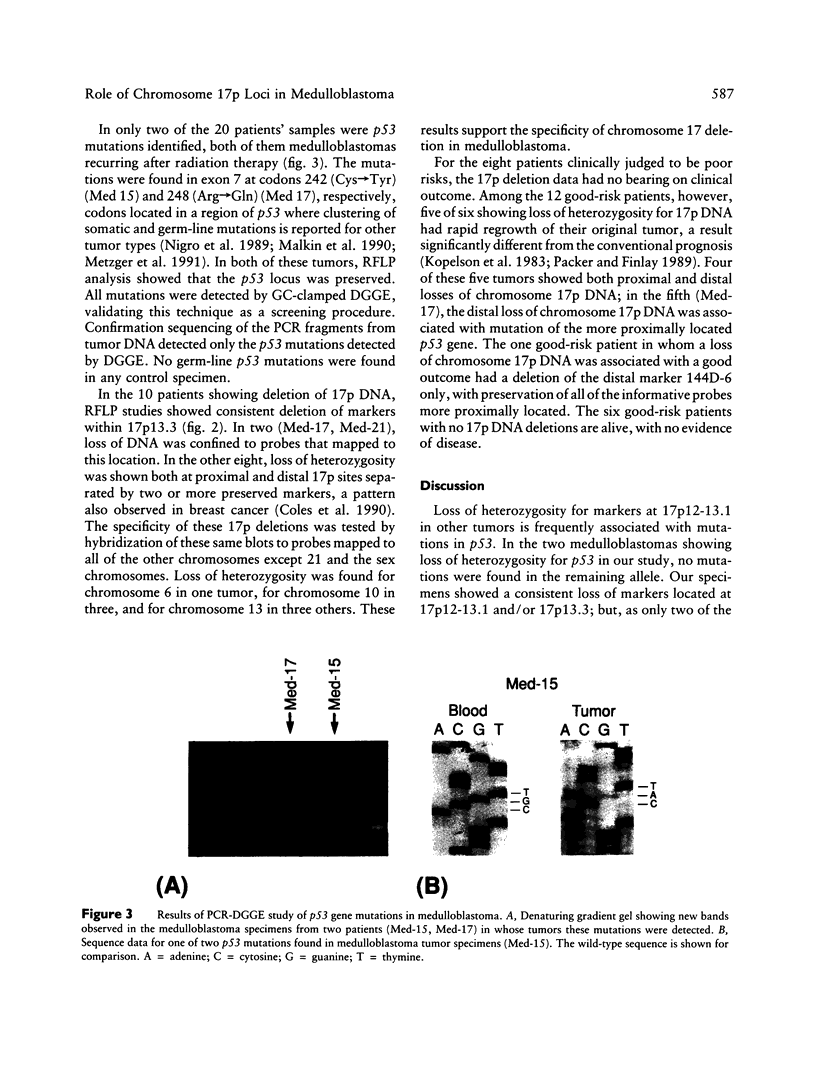
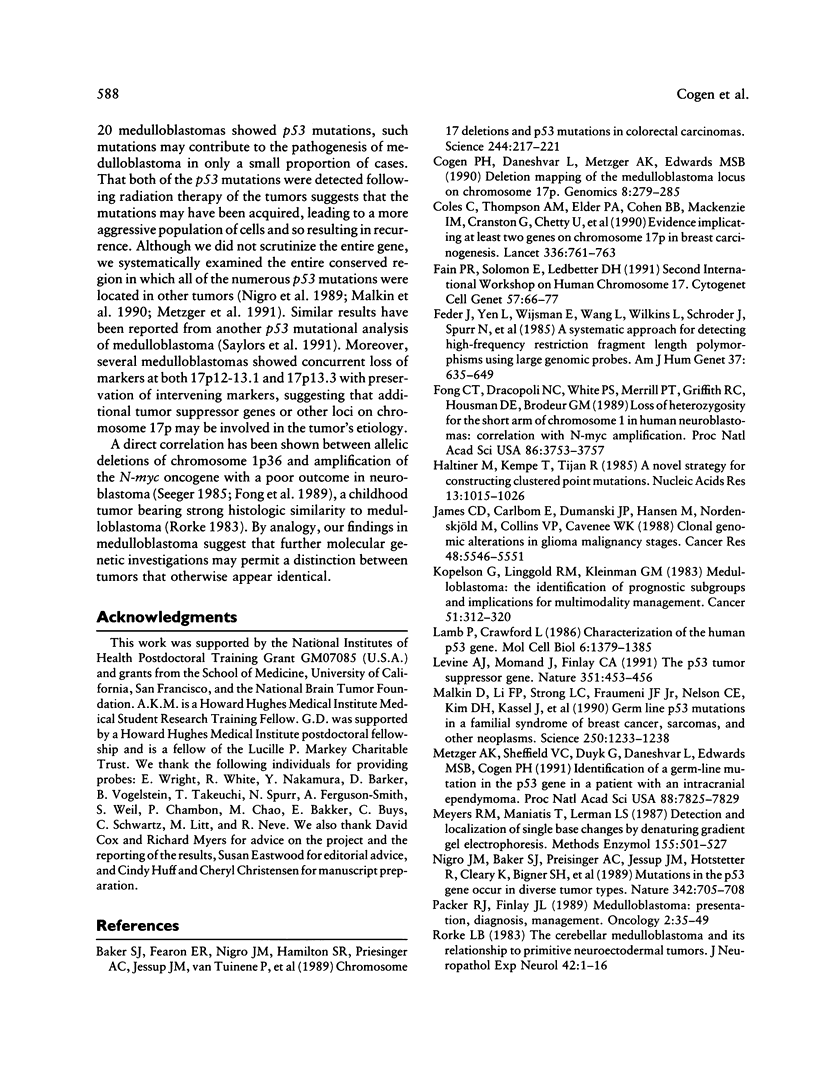
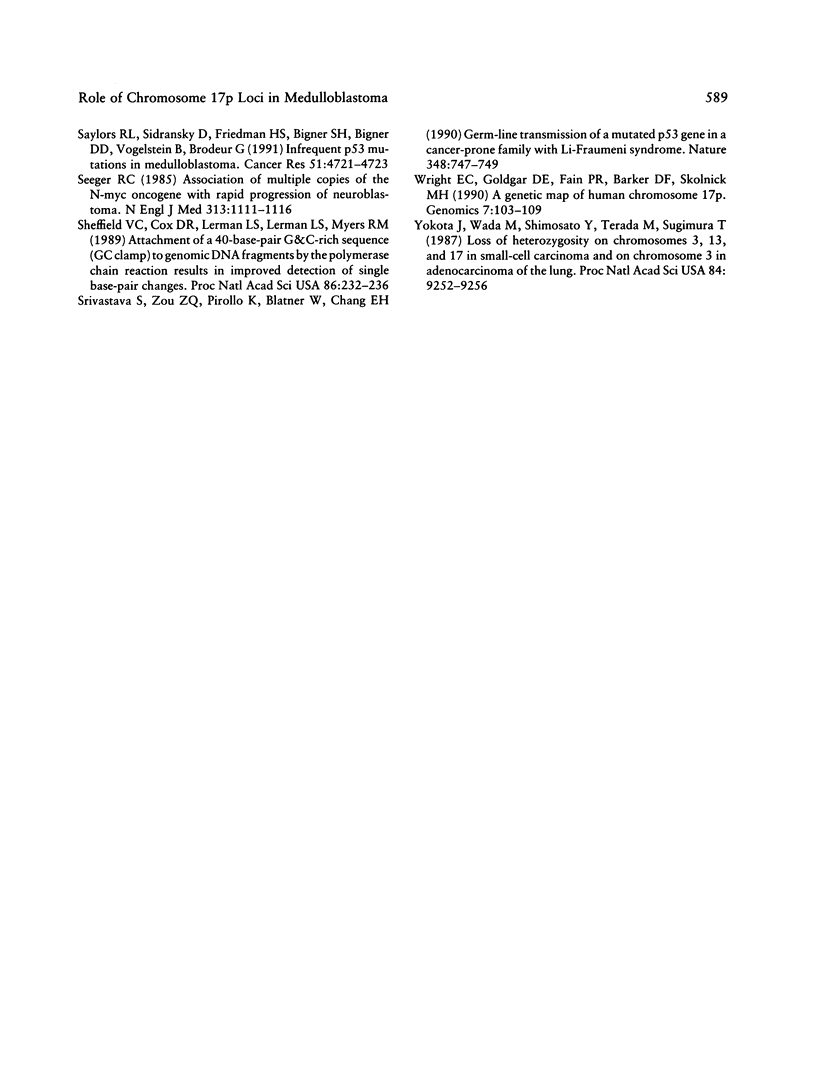
Images in this article
Selected References
These references are in PubMed. This may not be the complete list of references from this article.
- Baker S. J., Fearon E. R., Nigro J. M., Hamilton S. R., Preisinger A. C., Jessup J. M., vanTuinen P., Ledbetter D. H., Barker D. F., Nakamura Y. Chromosome 17 deletions and p53 gene mutations in colorectal carcinomas. Science. 1989 Apr 14;244(4901):217–221. doi: 10.1126/science.2649981. [DOI] [PubMed] [Google Scholar]
- Cogen P. H., Daneshvar L., Metzger A. K., Edwards M. S. Deletion mapping of the medulloblastoma locus on chromosome 17p. Genomics. 1990 Oct;8(2):279–285. doi: 10.1016/0888-7543(90)90283-z. [DOI] [PubMed] [Google Scholar]
- Coles C., Thompson A. M., Elder P. A., Cohen B. B., Mackenzie I. M., Cranston G., Chetty U., Mackay J., Macdonald M., Nakamura Y. Evidence implicating at least two genes on chromosome 17p in breast carcinogenesis. Lancet. 1990 Sep 29;336(8718):761–763. doi: 10.1016/0140-6736(90)93236-i. [DOI] [PubMed] [Google Scholar]
- Fain P. R., Solomon E., Ledbetter D. H. Second international workshop on human chromosome 17. Cytogenet Cell Genet. 1991;57(2-3):66–77. [PubMed] [Google Scholar]
- Feder J., Yen L., Wijsman E., Wang L., Wilkins L., Schroder J., Spurr N., Cann H., Blumenberg M., Cavalli-Sforza L. L. A systematic approach for detecting high-frequency restriction fragment length polymorphisms using large genomic probes. Am J Hum Genet. 1985 Jul;37(4):635–649. [PMC free article] [PubMed] [Google Scholar]
- Fong C. T., Dracopoli N. C., White P. S., Merrill P. T., Griffith R. C., Housman D. E., Brodeur G. M. Loss of heterozygosity for the short arm of chromosome 1 in human neuroblastomas: correlation with N-myc amplification. Proc Natl Acad Sci U S A. 1989 May;86(10):3753–3757. doi: 10.1073/pnas.86.10.3753. [DOI] [PMC free article] [PubMed] [Google Scholar]
- Haltiner M., Kempe T., Tjian R. A novel strategy for constructing clustered point mutations. Nucleic Acids Res. 1985 Feb 11;13(3):1015–1025. doi: 10.1093/nar/13.3.1015. [DOI] [PMC free article] [PubMed] [Google Scholar]
- James C. D., Carlbom E., Dumanski J. P., Hansen M., Nordenskjold M., Collins V. P., Cavenee W. K. Clonal genomic alterations in glioma malignancy stages. Cancer Res. 1988 Oct 1;48(19):5546–5551. [PubMed] [Google Scholar]
- Kopelson G., Linggood R. M., Kleinman G. M. Medulloblastoma. The identification of prognostic subgroups and implications for multimodality management. Cancer. 1983 Jan 15;51(2):312–319. doi: 10.1002/1097-0142(19830115)51:2<312::aid-cncr2820510225>3.0.co;2-y. [DOI] [PubMed] [Google Scholar]
- Lamb P., Crawford L. Characterization of the human p53 gene. Mol Cell Biol. 1986 May;6(5):1379–1385. doi: 10.1128/mcb.6.5.1379. [DOI] [PMC free article] [PubMed] [Google Scholar]
- Levine A. J., Momand J., Finlay C. A. The p53 tumour suppressor gene. Nature. 1991 Jun 6;351(6326):453–456. doi: 10.1038/351453a0. [DOI] [PubMed] [Google Scholar]
- Malkin D., Li F. P., Strong L. C., Fraumeni J. F., Jr, Nelson C. E., Kim D. H., Kassel J., Gryka M. A., Bischoff F. Z., Tainsky M. A. Germ line p53 mutations in a familial syndrome of breast cancer, sarcomas, and other neoplasms. Science. 1990 Nov 30;250(4985):1233–1238. doi: 10.1126/science.1978757. [DOI] [PubMed] [Google Scholar]
- Metzger A. K., Sheffield V. C., Duyk G., Daneshvar L., Edwards M. S., Cogen P. H. Identification of a germ-line mutation in the p53 gene in a patient with an intracranial ependymoma. Proc Natl Acad Sci U S A. 1991 Sep 1;88(17):7825–7829. doi: 10.1073/pnas.88.17.7825. [DOI] [PMC free article] [PubMed] [Google Scholar]
- Myers R. M., Maniatis T., Lerman L. S. Detection and localization of single base changes by denaturing gradient gel electrophoresis. Methods Enzymol. 1987;155:501–527. doi: 10.1016/0076-6879(87)55033-9. [DOI] [PubMed] [Google Scholar]
- Nigro J. M., Baker S. J., Preisinger A. C., Jessup J. M., Hostetter R., Cleary K., Bigner S. H., Davidson N., Baylin S., Devilee P. Mutations in the p53 gene occur in diverse human tumour types. Nature. 1989 Dec 7;342(6250):705–708. doi: 10.1038/342705a0. [DOI] [PubMed] [Google Scholar]
- Packer R. J., Finlay J. L. Medulloblastoma: presentation, diagnosis and management. Oncology (Williston Park) 1988 Sep;2(9):35-45, 48-9. [PubMed] [Google Scholar]
- Rorke L. B. The cerebellar medulloblastoma and its relationship to primitive neuroectodermal tumors. J Neuropathol Exp Neurol. 1983 Jan;42(1):1–15. [PubMed] [Google Scholar]
- Saylors R. L., 3rd, Sidransky D., Friedman H. S., Bigner S. H., Bigner D. D., Vogelstein B., Brodeur G. M. Infrequent p53 gene mutations in medulloblastomas. Cancer Res. 1991 Sep 1;51(17):4721–4723. [PubMed] [Google Scholar]
- Seeger R. C., Brodeur G. M., Sather H., Dalton A., Siegel S. E., Wong K. Y., Hammond D. Association of multiple copies of the N-myc oncogene with rapid progression of neuroblastomas. N Engl J Med. 1985 Oct 31;313(18):1111–1116. doi: 10.1056/NEJM198510313131802. [DOI] [PubMed] [Google Scholar]
- Sheffield V. C., Cox D. R., Lerman L. S., Myers R. M. Attachment of a 40-base-pair G + C-rich sequence (GC-clamp) to genomic DNA fragments by the polymerase chain reaction results in improved detection of single-base changes. Proc Natl Acad Sci U S A. 1989 Jan;86(1):232–236. doi: 10.1073/pnas.86.1.232. [DOI] [PMC free article] [PubMed] [Google Scholar]
- Srivastava S., Zou Z. Q., Pirollo K., Blattner W., Chang E. H. Germ-line transmission of a mutated p53 gene in a cancer-prone family with Li-Fraumeni syndrome. Nature. 1990 Dec 20;348(6303):747–749. doi: 10.1038/348747a0. [DOI] [PubMed] [Google Scholar]
- Wright E. C., Goldgar D. E., Fain P. R., Barker D. F., Skolnick M. H. A genetic map of human chromosome 17p. Genomics. 1990 May;7(1):103–109. doi: 10.1016/0888-7543(90)90524-x. [DOI] [PubMed] [Google Scholar]
- Yokota J., Wada M., Shimosato Y., Terada M., Sugimura T. Loss of heterozygosity on chromosomes 3, 13, and 17 in small-cell carcinoma and on chromosome 3 in adenocarcinoma of the lung. Proc Natl Acad Sci U S A. 1987 Dec;84(24):9252–9256. doi: 10.1073/pnas.84.24.9252. [DOI] [PMC free article] [PubMed] [Google Scholar]



